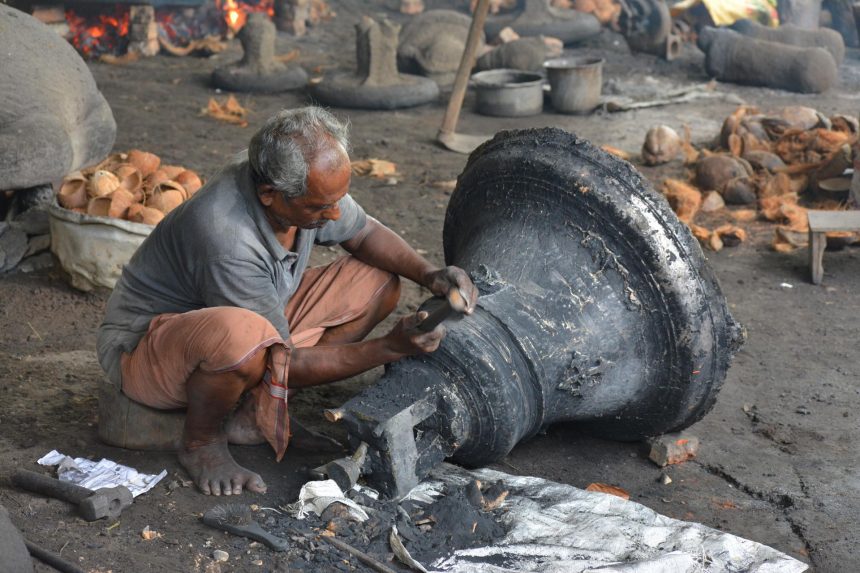Nestled along the banks of the Pampa, Manimala, and Achankovil rivers, the village of Mannar in Alleppey, Kerala, stands as a beacon of ancient craftsmanship. This serene village, with its rich history dating back to the 8th century AD, is renowned for its exquisite bell metal handicrafts. From ornate lamps and cauldrons to intricate door locks and bells, Mannar’s bell metal industry is a testament to the region’s enduring artistic heritage.
A Historical Perspective
The origins of Mannar’s bell metal industry can be traced back to the period of Hindu renaissance, when the construction of grand temples necessitated the skills of metal crafters. This demand led to the migration of artisans to Mannar, where they found patronage under the local kings. As these artisans settled and prospered, the fame of Mannar’s metal crafts spread across India.
The Craftsmanship of Bell Metal
Bell metal, an alloy primarily composed of 78% copper and 22% tin, is distinguished by its high density and resonant sound. This alloy is celebrated not only for its durability and utility but also for its aesthetic and cultural significance. The positive influence of bell metal on food quality and its auspicious nature, akin to gold, have made bell metal utensils a staple in both royal and common households.
The Varpu: Pride of the Industry
Among the many products crafted in Mannar, the Varpu, a large cauldron, holds a place of pride. These cauldrons are not just utilitarian but are also significant cultural artifacts. The ancient Sri Krishna Temple in Guruvayoor and the Sri Padmanabha Temple in Trivandrum house some of the largest Varpus, reflecting the scale and grandeur of this craft.
The Allure of Lamps
Mannar’s bell metal lamps are masterpieces of design and function. Available in various forms—handheld, floor-standing, wall-mounted, and ceiling-hung—these lamps are integral to Kerala’s cultural and religious practices. The Changalavatta, resembling a bird, is particularly noted for its use in temple processions. These lamps, often adorned with figures of peacocks, lions, and flowers, are central to auspicious ceremonies and traditional performances like Kathakali and Mohiniattom.
The Manichitra Thaazhu: Symbol of Heritage
The Manichitra Thaazhu, a traditional bell metal lock, is another signature product of Mannar. Known for its intricate engravings and complex locking mechanism, this lock symbolizes the heritage and tradition of Kerala homes. Its strength and durability make it a cherished heirloom, passed down through generations.
The Intricate Process of Bell Metal Casting
The creation of bell metal artifacts involves a meticulous process rooted in ancient techniques. The process begins with the preparation of a clay mold, which is coated with wax and then layered with more clay and jute for reinforcement. The mold is then dried, baked, and filled with molten bell metal alloy. After cooling, the mold is broken to reveal the unfinished product, which is then polished to perfection.
Raw Materials and Techniques
The raw materials used in bell metal crafting include smooth clay from riverbanks, honeybee wax, coconut oil, and scrap metals. The traditional lost wax method, guided by ancient texts like Tantra Samuchaya and Silpa Ratna, ensures the precise proportions and design intricacies required for each piece. The entire process, from molding to casting, is a labor-intensive task requiring both skill and patience.
The Vishwakarma Legacy
The artisans of Mannar belong to the Vishwakarma community, revered for their lineage tracing back to Lord Vishwakarma, the divine architect. This community is divided into five categories based on their specializations: Asaari (woodwork), Moosaari (metalwork), Thattaan (gold jewelry making), Kallaassery (stone designing and carving), and Kollan (iron tool making). Each category contributes uniquely to the rich tapestry of Kerala’s traditional crafts.
A Community of Skilled Artisans
Today, around 50 families in Mannar continue this age-old craft, working individually or collaborating with larger forges. Their foundries are alive with activity from 9 am to 5 pm, producing a wide range of products that continue to evolve with market demands. Despite modern challenges, these artisans maintain the high standards and intricate designs that have made Mannar’s bell metal crafts renowned.
Conclusion
The bell metal craft of Mannar is more than just an industry; it is a living heritage that reflects the rich cultural history of Kerala. Through their dedication and skill, the artisans of Mannar continue to create timeless pieces that are both functional and beautiful, ensuring that this ancient craft remains vibrant for future generations. Explore and learn and see them in action while you cruise between Alleppey and Kochi onboard MV Vaikundam 7 night River Cruise

















Leave a Reply
You must be logged in to post a comment.